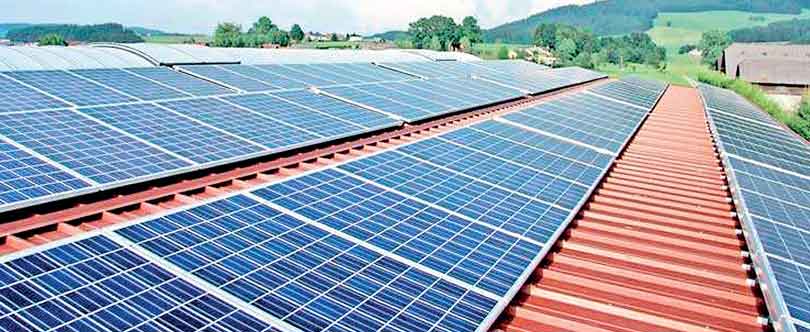Saturday Apr 19, 2025
Saturday Apr 19, 2025
Tuesday, 10 December 2024 01:26 - - {{hitsCtrl.values.hits}}

Harnessing RE resources offers energy security and creates avenues for investment with skilled job opportunities opening for management, financial and technical specialists
Some of the factors that discourage investment flow and impede rapid development are the current sovereign credit risk ratings, state of the economy, risks associated with the principal sector player – the CEB, uncertainties associated with ongoing power sector reforms, cumbersome regulatory framework and seeming ineffectiveness of the regulator – PUCSL, expressions of environmental concern and geopolitics that influences project financing and development
 I was an attendee at the International Conference on “Reimagining of the Electricity Industry for the Future” held on 28 November 2024 organised by the Sri Lanka branch of The Institution of Engineering and Technology. The event was well attended and enlightening. My sincere thanks to the organisers for staging this impressive event.
I was an attendee at the International Conference on “Reimagining of the Electricity Industry for the Future” held on 28 November 2024 organised by the Sri Lanka branch of The Institution of Engineering and Technology. The event was well attended and enlightening. My sincere thanks to the organisers for staging this impressive event.
Panellists from India shared their experiences of the rapidly changing and expanding electricity industry in their country with grid unbundling, ambitious renewable energy (RE) penetration plans and private sector participation through competitive bidding. India – an industrial economy with a large population and covering an extensive land mass – and Sri Lanka have similarities (electricity and RE trends) and differences (over 70% coal fired electricity generation in India). The India experiences gained on the RE front from the technologies utilised and commercial strategies adopted have significant relevance to the planners in Sri Lanka.
The panellists from Sri Lanka presented the electricity sector expansion plans for meeting the GoSL goal of 70% RE based electricity by the year 2030 and meeting the 5% per annum growth in demand forecasted over the same period. Attaining these milestones will be challenging, and these are known to the planners.
This narrative focuses on the challenges faced. These are, a) the quantum of investment required for developing the power plants and transmission infrastructure, b) LNG procurement, c) climate change induced weather patterns impacting hydropower output (excess rainfall and long duration droughts) and d) securing land for RE plants (wind and solar).
A combination of the above factors leaning in the negative direction will lead to excessive use of fossil fuelled plants and diesel generation that results in a higher electricity production cost. Power cuts in the future cannot be ruled out. This presents a serious dilemma for a government that is committed to reducing the consumer electricity tariff.
The notes that follow are based on extracts from the writer’s submittal to the PUCSL Stakeholder Consultation on the Draft Long Term Generation Expansion Plan (LTGEP) 2025-2044 and opinions expressed at the conference during the Q&A session and at forums elsewhere.
Investment for developing power plants and transmission infrastructure
Local businesses will not be able to raise the estimated investment of over $ 2 billion required for constructing plants and related infrastructure by the year 2030.
Some of the factors that discourage investment flow and impede rapid development are the current sovereign credit risk ratings, state of the economy, risks associated with the principal sector player – the CEB, uncertainties associated with ongoing power sector reforms, cumbersome regulatory framework and seeming ineffectiveness of the regulator – PUCSL, expressions of environmental concern and geopolitics that influences project financing and development.
To overcome these challenges, Sri Lanka must address several key factors that are listed below:
1. Improve Sovereign Credit Risk Ratings: Sound economic policies and demonstration of fiscal responsibility helps to attract international investors.
2. Enhance Economic Stability: Controlling inflation, reducing debt, and fostering economic growth to make Sri Lanka a more attractive destination for international financing.
3. Address Sector-Specific Risks: Risks posed by CEB - the key sector player, through reforms and improving the efficiency and transparency of the institution to build investor confidence.
4. Streamline Regulatory Framework: Ensuring the effectiveness of the PUCSL to create a more conducive environment for investment. Removing other bureaucratic bottlenecks is also necessary.
5. Mitigate Environmental Concerns: Addressing stakeholder concerns and ensuring that RE projects comply with environmental standards, and streamlining the approval process to help attract environmentally conscious investors.
6. Navigate Geopolitical Influences: Building strong diplomatic relations and overcoming geopolitical challenges effectively to help secure international financing.
By focusing on these areas, Sri Lanka can improve the ease of doing business and can create a more attractive environment for international investors and secure the necessary financing and technical and business capabilities to achieve its electricity growth rate and RE goals.
LNG procurement
The CEB LTGEP 2025-2044 refers to the expectation of LNG supply to about 700 MW of dual fuel (diesel, LNG) power plants by the year 2027 (“heavy dependency in future”).
While this is a complex subject that is best left to experts and analysts to address at other forums, the writer has red flagged this matter in the belief that the probability of attaining this milestone within the next decade is extremely low. Thus, the lack of LNG supply will result in thermal plant operation on expensive diesel fuel that will lead to an increased electricity tariff.
Climate change and hydropower generation uncertainty
SL hydropower plant operations face the risk of major disruption due to extreme variations in rainfall. This is a global phenomenon. A long period of drought and heavy rainfall over a shorter duration of time makes this promising resource less reliable. The inter-year variability is evident from comparing the hydropower reservoir generation capacities during the high hydro period (Dec-Jan) to the low hydro period (Jun-Jul) with the variability significantly increasing within the past decade. This will have a disruptive effect on the hybrid national power system (fossil, hydro, variable RE) requiring considerable backup capacities to make up for dry years. Additionally, in good hydro years the valuable resource is wasted through dam spillage.
The risks of long periods of drought will force excessive reliance on thermal generation and diesel fuel driven plants for meeting the electricity demand driving up costs and tariffs, or alternatively, power cuts which can be even more costly.
Land allocation for utility scale wind and solar
The LTGEP features a significant quantum of solar and wind capacity additions. Land zoning is key. Initial environmental examinations must be conducted and fatal flaws (if any) identified. If this work is not performed upfront with land secured under State mandate, the RE development program will be disrupted and delayed. Sri Lanka Sustainable Energy Authority has the legal basis for securing such land, but its powers have not been effectively used.
Land use planning in the context of utility scale wind and solar is essential. Wind farms can be subject to dual use where agriculture, animal husbandry, forestry, process industries, etc. can take place. Same is the case with solar (agrivoltaics) and floating solar PV.
The typical physical footprint of a wind farm is less than 3% of the extent of spread on the land occupied. Clearing forest land and allocating scattered housing plots in RE resource rich land may be politically expedient, but hurts the national interest.
Agrivoltaics is the dual use of land for solar energy production and agriculture. Many agricultural activities can be combined with solar, including plant crops, livestock, greenhouses, etc.
When locating wind farms close to avian habitats, the study of wind industry practices in migratory bird rich regions in many parts of the world should be conducted for addressing concerns about avian issues. SL specific guidelines should be formulated by a multidisciplinary team that consists of various stakeholders. This is not a black and white issue, and compromises must be made for the sake of the overall national interest.
In the case of solar, priority needs to be given to using roof-tops or covered spaces before using agricultural, fallow or forest lands. This requires improved incentives, strengthened distribution networks, and clear regulations and importantly, good governance.
Aggressive push towards RE dominance essential
The risks identified above make it imperative that SL pursue an aggressive path towards RE dominance with utility scale wind and solar + distributed generation via roof top solar and micro grids. Wind/solar hybrid plants with battery energy storage systems (BESS) help to improve project economics and enhances grid integration.
Benefitting from distributed solar on roof-tops and covered spaces will require working with prosumers. A prosumer is a producer/consumer of electricity and an electric utility subscriber with roof top solar, BESS and smart controls who is subject to a market rate electricity tariff with ‘time of hour’ metering, peak demand charge and demand side management programs. The subscriber will be financially incentivised to adopt state of the art technologies to control consumption during high tariff rates and shave peak demand level by shutting off appliances.
With a sizable SL population resident in rural regions the development of micro grids for rural electricity supply based on Solar PV with BESS will also provide benefits such as curbing electricity demand from fossil fuelled plants and help to reduce transmission and distribution losses.
Harnessing RE resources offers energy security and creates avenues for investment with skilled job opportunities opening for management, financial and technical specialists.
SL is aspiring to be a digital economy. As the world increasingly shifts towards digitalisation, this transformation is aligned with sustainable practices. Green technologies must drive a sustainable digital economy. This course firmly aligns with national development goals.
(The writer is a Management Consultant and Renewable Energy Specialist. He can be reached at: [email protected].)
Discover Kapruka, the leading online shopping platform in Sri Lanka, where you can conveniently send Gifts and Flowers to your loved ones for any event including Valentine ’s Day. Explore a wide range of popular Shopping Categories on Kapruka, including Toys, Groceries, Electronics, Birthday Cakes, Fruits, Chocolates, Flower Bouquets, Clothing, Watches, Lingerie, Gift Sets and Jewellery. Also if you’re interested in selling with Kapruka, Partner Central by Kapruka is the best solution to start with. Moreover, through Kapruka Global Shop, you can also enjoy the convenience of purchasing products from renowned platforms like Amazon and eBay and have them delivered to Sri Lanka.
Discover Kapruka, the leading online shopping platform in Sri Lanka, where you can conveniently send Gifts and Flowers to your loved ones for any event including Valentine ’s Day. Explore a wide range of popular Shopping Categories on Kapruka, including Toys, Groceries, Electronics, Birthday Cakes, Fruits, Chocolates, Flower Bouquets, Clothing, Watches, Lingerie, Gift Sets and Jewellery. Also if you’re interested in selling with Kapruka, Partner Central by Kapruka is the best solution to start with. Moreover, through Kapruka Global Shop, you can also enjoy the convenience of purchasing products from renowned platforms like Amazon and eBay and have them delivered to Sri Lanka.